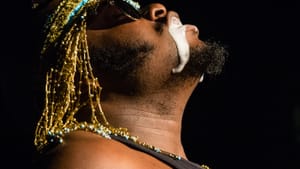Stay in the Loop
BSR publishes on a weekly schedule, with an email newsletter every Wednesday and Thursday morning. There’s no paywall, and subscribing is always free.
The body as resistance and protest
Jaamil Olawale Kosoko’s 'Black Male Revisited'

I remember my first encounter with Black Male Revisited: Songs for the Dark Divine, a work conceived and created by Nigerian-American performance artist Jaamil Olawale Kosoko. I remember my anger at the viewers reacting with nervous laughter when Kosoko would tell a story of his past. I also remember my joy at the display of books by black scholars, whose work sheds light on a truth not necessarily taught in schools.
But what I remember most was leaving, wanting to experience it all over again.
In its evolved state, Kosoko’s piece is still a riveting multimedia presentation that encourages us to question “self” as we navigate a not-so-post–racial world. With no clearly designated front, back, upstage, or downstage, Kosoko meandered around asking viewers to constantly change their point of focus. Maybe this was to keep the audience alert, or maybe it was an invitation to heighten awareness of our bodies in space and to be conscious of our surroundings — as most people of color are asked to do on a daily basis.
A live documentary
Using original song, dance, and first-person narrative, Kosoko has crafted a live documentary that intertwines the skills of New York-based performance artist Jonathan Gonzalez and sound engineer Jeremy Toussaint-Baptiste. Gonzalez sometimes played the role of stagehand (making sure props were at hand) and as the partner in a in which he held a camera, creating a live stream on a screen for the audience. Sometimes the interactions drew them close together, and, like a tango, one led and the other followed. It wasn’t clear whether these duets were choreographed or improvised.
In another section, Kosoko, wearing a cobra-bedecked headdress, consumed the contents of a bleach bottle. He began to spew a foamy white liquid from his mouth while his body convulsed, creating a juxtaposition between the rhythmic trembling of his body and the droning soundscape engineered by Toussaint-Baptiste. A symbolic representation of white supremacy, Kosoko’s vibrating body worked to oust this whiteness from his black, possessed body in a visually disturbing metaphor that still haunts me.
Songs of the Dark Divine is an embodied depiction of the black male existence in America through the eyes of Kosoko. The multitude of cultural references, images, and stories calls us to unshackle systematic oppression.
This time, I left equally full, with an added layer of gratitude.
What, When, Where
Jaamil Olawale Kosoko, Black Male Revisited : Songs for the Dark Divine. February 25-27, 2016 at the Painted Bride Art Center, 230 Vine Street, Philadelphia. 215-925-9914 or paintedbride.org
Sign up for our newsletter
All of the week's new articles, all in one place. Sign up for the free weekly BSR newsletters, and don't miss a conversation.
 Gregory King
Gregory King